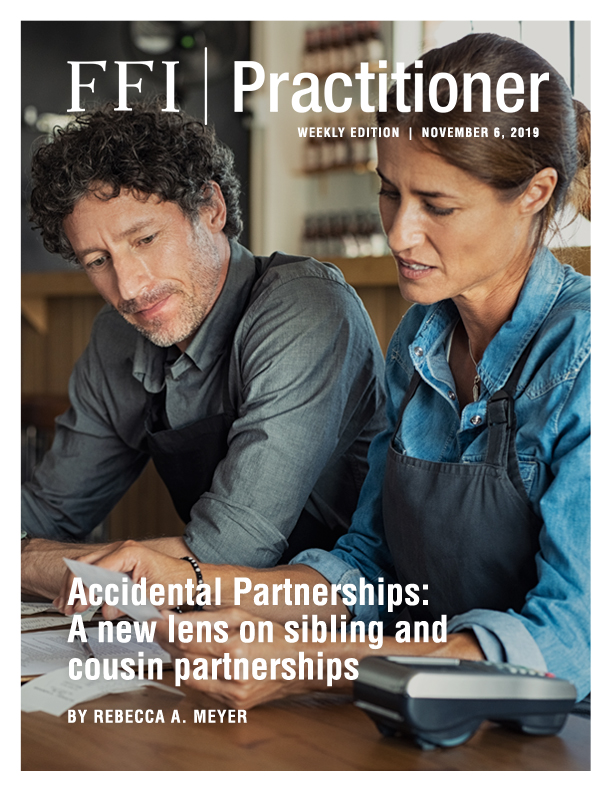
At first, it seemed ridiculous – how could they possibly fill the shoes of their father, Greg, who built such a remarkable portfolio of commercial real estate holdings? And how would they ever figure out how to work together?
Carla, Gabe, and Jesse Field were raised to be independent. All three have had successful careers outside of their father’s business, although Jesse did start working for Greg a few years ago. While the three siblings have always had a lot of fun at holidays and on family vacations, they never spent much time thinking about what would happen to their father’s real estate business when he was gone. Now all in their 30’s, with their father’s recent diagnosis, they are shocked and grief stricken as they begin to contemplate how to prepare for a new reality which will result in an accidental partnership.
When siblings or cousins become partners in the management of family assets – real estate, an operating business, an investment partnership, a private foundation, or even the settlement of a complex estate – they are often “accidental” partners. Accidental partners, even if they are siblings or cousins, have not made an active choice to create a long-term economic relationship, one that comes with substantial demands, opportunities, and risks. Some accidental partners think of themselves simply as inheritors of family resources without having a clear sense of what will be required once they become the primary owners responsible for the management of the assets.
While much has been written about generational succession in family businesses,1 the focus of this article is to use a new lens to look at one specific aspect of preparing the next generation – fostering successful next generation partnerships in unexpected circumstances. Three challenges that accidental partnerships often face are: feeling trapped, overcoming relationship obstacles, and managing differences. Since these challenges, unaddressed, can threaten family enterprise sustainability,2 this article explores each and suggests approaches to preventing or mitigating them.
Feeling Trapped
Carla, Gabe and Jesse couldn’t have had more divergent reactions to learning that their parents, Greg and Marta, wanted them to prepare to run Greg’s business in the near future.
Carla is ready to leave the start-up world, where she’s run operations for several entrepreneurial ventures, and she’s looking forward to the excitement of learning the real estate business at a deeper level. Gabe is feeling overwhelmed. He’s just made partner at the firm where he’s enjoyed working since law school and he can’t imagine how he will manage the time demands of his work, his young family, and now Greg’s business, too. He doesn’t want to offend his parents or siblings, and he doesn’t see any graceful way out. Initially, Jesse is annoyed at the idea of having any of his siblings “crowd his turf.” As the situation sinks in, however, he realizes that he’d like to have their help managing the enormous responsibility.
Greg and Marta planted the seeds of their children’s partnership when they first began to give Carla, Gabe, and Jesse shares of their properties in trust as part of their estate planning. Certainly, when Greg started out, he and Marta never imagined that the business would be so successful.
“Identifying relationship obstacles, whether they are between members of the next generation, members of previous generations, or some combination of the two, may help family members see a key element that’s in the way of their business partnership.”
Suggestions to Avoid Feeling Trapped
Just as early tax and estate planning provides the greatest financial benefits, time is a critical factor for preparing family members for the multiple ways that planning will impact their lives. At the point when they began gifting significant assets, it would have been helpful for Greg and Marta to embark on conversations about the next generation’s role in managing the family holdings — even if the children were too young to be part of those initial discussions and the timing seemed far away. This is especially true if several next generation family members each receive partial ownership of illiquid assets like real estate or shares of an operating business that will demand significant joint decision-making.
Here are other ways to minimize the sense of feeling trapped:
- Use stories to make the connection between the financial benefits that the next generation receives and what goes into managing the assets.
- Balance the messages. Encourage the next generation to find their own passion and let them know that, at some point, they may need to get involved in order to continue to enjoy the financial benefits of the family holdings.
- Differentiate between ownership and management through appropriate governance processes and structures. While the first generation may fuse the two roles, many members of the next generations may prefer to act as owners while continuing to pursue their own interests, with professional managers running the day-to-day operations at the company.
Sidebar
Overcoming Relationship Obstacles
Carla and Gabe think that Jesse, as the youngest, is the favorite and “gets away with murder,” while Jesse has a chip on his shoulder for having been under the microscope during high school when his older siblings were off at college. This lingering resentment isn’t a big factor on holidays. However, as soon as Greg and Marta began to include the next generation in conversations about the future of the business, these sibling dynamics quickly surfaced. When Marta expressed her enthusiasm for Jesse’s entrepreneurial idea for one of the properties, Carla and Gabe roll their eyes and immediately bring up several reasons why it won’t work. Jesse didn’t say a word for the rest of the meeting.
In general, when the primary management and ownership decisions are being made by the founding generation, unresolved conflict among siblings and/or cousins is often swept under the rug without significant consequences. However, once the next generation partners have a seat at the table, reactivity among them can obstruct productive business conversations if the underlying dynamic remains unaddressed.
Suggestions for Overcoming Relationship Obstacles
Identifying relationship obstacles, whether they are between members of the next generation, members of previous generations, or some combination of the two, may help family members see a key element that’s in the way of their business partnership. In the case of the Field family, the advisor could suggest that each individual articulates his or her own narrative about what transpired when the older two siblings left for college and Jesse was still at home, and help the siblings to create a shared narrative about these events and the impact on their relationships. That effort can help to remove the charge of those events, so that future business conversations don’t become stuck on the old dynamic.
Managing Differences
The three Field offspring are, of course, different from one another. Carla is entrepreneurial and goal oriented. Gabe is analytical and risk averse. Jesse is creative and a little disorganized. When they recently planned a surprise 40th anniversary party for their parents, they struggled with their different styles, but managed to divide up the tasks in a way that played to each of their strengths. With the stakes now quite a bit higher in their work together in the family business, they’ve each expressed concern about how they’ll learn to work together constructively.
Every partnership must contend with the basic task of managing differences – differences in styles, skills, and personal preferences, among others. These differences are both a benefit and a challenge in partnerships. For example, when one partner is more detail-oriented and the other more strategic, the partnership benefits from a diversity of skills and focus. That diversity can create challenges when the partners’ priorities don’t align. Ideally, partners can bridge their differences without undue emotional reactivity.
Accidental partnerships also have to learn to manage normal human differences – and it may help sibling and cousin teams to be reminded of this reality. Family members may assume that what they have in common, such as shared experiences and beliefs, makes collaborating around their shared assets easier. And it may, to a point. However, the long-term emotional history that family members share means that both helpful and challenging patterns of relating are passed down from one generation to the next.
Suggestions for Managing Differences
- Help family members take an interest in their multi-generational patterns of functioning and relating and where they fit. Being able to see the patterns offers family members the option to make a choice about whether to continue or change the patterns.3
- Provide education or workshops about partnering and find opportunities for the next generation to gain experiences in joint decision-making.
- Develop governance practices and processes that make room for different styles and allow individuals to feel heard while keeping decision-making on track.
- Invest in learning skills for high stakes conversations. Crucial Conversations by Al Switzler, Joseph Grenny, and Ron McMillan is a helpful resource.
Conclusion
Using the lens of accidental partnerships provides a perspective that can alert families and their advisors to a set of challenges that may be important to address in their efforts to prepare the next generation to lead the family enterprise.
Successful next generation partnerships require a degree of intentionality that is often challenging for accidental partners to attain. Using this lens can help families identify and address the issues rather than allowing them to persist and undermine the family’s efforts to foster successful next generation partnerships. It can be helpful for sibling and cousin co-owners just to know that some challenges are normal for all partnerships and that there are ways to mitigate the unique challenges of accidental partnerships.
References
1Two examples of many are: John James Cater, III, Roland E. Kidwell, Kerri M. Camp “Successor Team Dynamics in Family Firms”, Family Business Review, 2016, Vol. 29(3) 301–326; and Ivan Lansberg, Succeeding Generations, Harvard Business Review Press, 1999.
2These implications arise out of the six dimensions of the Relative Solutions’ Family Enterprise Sustainability Model: Family Legacy and Connection, Governance Structures and Processes, Financial Management and Accountability, Human Capital and Leadership Development, and Generosity and Gratitude. These are described in detail in Fredda Herz Brown’s forthcoming book, The Essential Roadmap: Navigating Family Sustainability in a Changing World.
3Fredda Herz Brown, PhD and Fran Lotery, PhD, The Family Wealth Sustainability Toolkit, The Manual, Wiley, 2012, p. 8-9.

Up Next Week

by Rochelle Mendelsohn

